| <<=PREVIOUS |
NEXT=>> |
The 1840 Second Fort Smith Army Post and A Fledgling City |
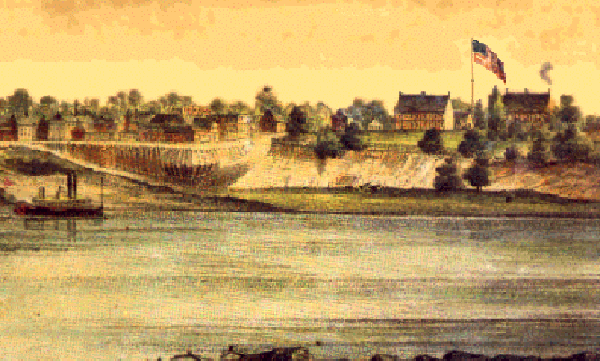
Little Gibraltar on The Arkansas. This is a painting depicts the fort and the river front of the city of Fort Smith as it looked in 1853. |
In 1838, fourteen years after the original fort was abandoned by the army,
construction started on a second Fort Smith. The white settlers
of the area had petitioned Congress for a new fort because of an unfounded
fear of trouble due to the influx of Indians into the Indian Territory.
Many Native Americans from the Five Civilized Tribes were settling on
the Indian lands.
At the left is one of the earliest pictures we have of the new fort - an artist's painting
made in 1853 of "The Little Gibraltar on The Arkansas" - the
growing town of Fort Smith is depicted on the left above the banks of the Arkansas River.
The new stone fort consisted of two large buildings housing the officer
quarters and administration offices (seen at the right of the flag), and
officer's barracks in the center of the fort (left of the flag) and
a few other smaller buildings were enclosed in a six to eight foot stone wall. |
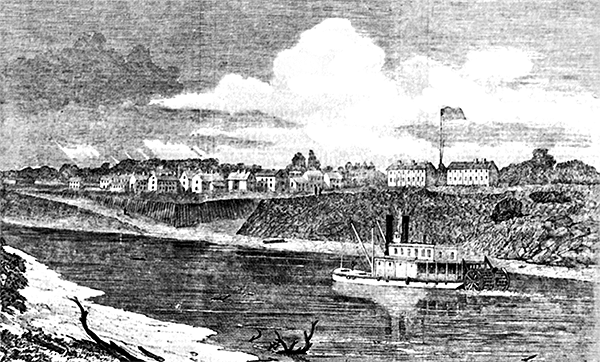
This is an undated woodcut perhaps as an illustration for a newspaper of the city (at left) and the 1840's fort. The vantage point of this illustration appears to be near the confluence of the Poteau and Arkansas Rivers. Steamboats could reach Van Buren (to the north east) and Fort Smith, but beyond that point sand bars and snags made the river unnavigable. The cut in the river bank seen here on the city side of the river bank was at the head of Garrison Avenue and the location of today's bridge into Oklahoma. Garrison Avenue was so named because the soldiers from the fort drilled and paraded along its length. |
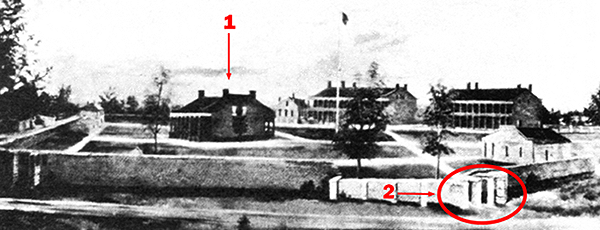
An artist's sketch of the 1840's fort before
the Civil War - view from Garrison Avenue. The two large buildings on
the right behind the flag pole are the officers' quarters and administrative
buildings. The building on the left (1) was the enlisted men's barracks,
which became Judge Parker's original courthouse. Only the commissary building (not shown here)
remains unchanged in the National Historic Site. A small portion of the original entrance into the fort (2) is today part of the entrance into today's site. The enlisted quarters, Parker's original court house was incorporated into the new court house
built during Parker's administration and survives on the site today. |
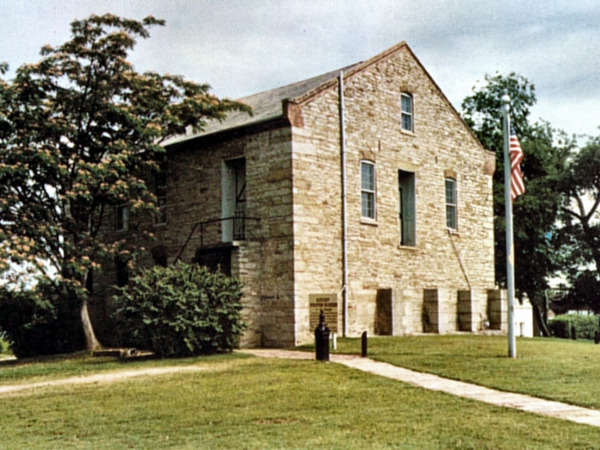
The old Commissary building is the only structure that remains as it was in the 1840's. It still stands today on the grounds of the National Historic Site. |
Col. Zachary Taylor took command of the fort in 1841 while it was still under
construction. In his opinion, "A more useless expenditure of money
and labor was never made by this or any other people...The sooner it is
arrested the better." The Army listened, and when Col. Taylor, future
president of the U.S., went off to fight the war with Mexico construction
was halted. Two block houses were left unfinished and two converted into
storehouses. In 1845 the fort became an Army supply depot.
The old commissary building (picture on the left) stood at the northeast corner of the fort, was
orignially one of the blockhouses of the 1840 fort. It is the only building still standing
that looks today as it did when the fort was an active Army post.
The enlisted barracks became Judge Parker's courthouse and jail.
It was enlarged and a jail wing added during Parker's time as judge, giving it the appearance it has
today. The other buildings and stone fortifications are now gone, although
a small portion of the main gate has been restored to its original location and is today the main entrance to the grounds. |
At the start of the Civil War, Federal forces abandoned the fort and Confederate
General and former U.S. Senator Solon Borland took command in April, 1863.
The fort remained in Confederate hands for about four months until September, 1863, when the advancing forces of Union General
James G. Blunt forced Confederate General William L. Cabell, the Confederate commander to retreat to the south of Fort Smith; the fort was once again under the U.S. flag. In 1864 Confederate forces revenged the Union occupation of Fort Smith with a definitive victorty at the Battle of Massard Parairie. Among the rebel troops were a number of Native Americans in the Confederate army and a significant factor in the Confederate victory. Massard Parairie is now an Arkansas historical site and park within the city limits.
In 1865 the fort was formally
reactivated. In that year a grand council of Oklahoma tribes ceded almost
half of all land claimed by them before the Civil War in restitution for
siding with the Confederacy. Much of this land was originally in western Arkansas.
By 1871 the frontier had moved so far west that the fort was no longer
useful, even as a supply depot, and it was again abandoned by the Army.
However, it was soon to become more famous as the seat of a federal court
than as a bastion against warring hoards that never materialized.
Under Judge Isaac Parker it became a bastion against the lawless west. |
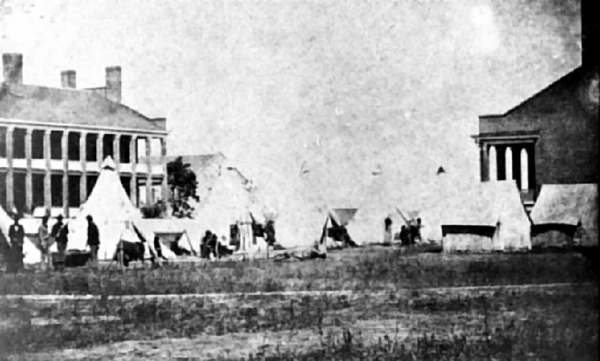
Photo of the fort during the Civil War. The building on the right became Parker's courthouse. The men in uniform appear to be Union
soldiers. Except for a brief period of Confederate occupation, the United States Army held the
military fort and the city of Fort Smith during the war. |
| <<=PREVIOUS |
NEXT=>> |



